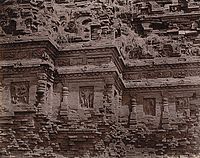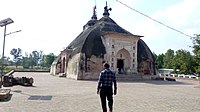Bhitargaon temple
 Bhitargaon temple in Kanpur district, Uttar Pradesh, India | |
| Location | Bhitargaon, Kanpur district, Uttar Pradesh, |
|---|---|
| Coordinates | 26°12′38″N 80°16′34″E / 26.210556°N 80.276111°E |
| Type | Hindu Temple |
| History | |
| Founded | Late 5th century CE |
| Cultures | Gupta Empire |
Bhitargaon is a town, near city of Kanpur in Kanpur district, Uttar Pradesh, India, known for its ancient Hindu temple, the largest Indian brick temple to survive from the time of the Gupta Empire. Despite being heavily restored, a number of original features remain.[1] It is dated to the late 5th century.[2]
Bhitargaon Temple

The Bhitargaon Temple is a terraced brick building fronted with a terracotta panel. Built in the 5th century during the Gupta period,[3][4][5][6][7][8][9][10] it is the oldest remaining brick/terracotta Hindu shrine with a roof and a high shikhara, though its upper chamber did sustain some damage in the 18th century.
The temple is built on a square plan with double-recessed corners and faces east. There is a tall pyramidal spire over the garbhagriha. The walls are decorated with terracotta panels depicting Shiva and Vishnu etc. When Alexander Cunningham first visited the site, the remains of the porch and of the ardhamandapa were still visible, which later collapsed.
Description of the architecture and layout of Bhitargaon temple
The construction material is bricks and terracotta. The brick size is 18" x 9 x 3" and the other salient features are following:
- The size of platform on which the temple is built is 36 feet x 47 feet.
- The sanctum is 15 feet x 15 feet internally.
- The sanctum is double story.
- The wall thickness is 8 feet.
- The total height from ground to top is 68.25 feet.
- There is no window.
- The terracotta sculpture depicts both secular and religious theme such as deities like Ganesha and Durga Mahisasurmardini. Myths and stories representing abduction of Sita and the penance of Nara-Narayana.
- Shikara is a stepped pyramid and got damaged by thunder in 1894.
- The first story of sanctum felled in 1850.
Behta Bujurg temple
There is another ancient temple in Behta Bujurg (or Behata Bujurg) village which is only 4.3 km far from Bhitargaon, also protected by the Archaeological Survey of India.[11] The temple is dedicated to Lord Jagannath, and has a highly unusual curving shape, with buddhist stupa(Mound) like resemblance. However a close look reveals nagara style curvilinear shape. There are significant detached ancient sculptures: Lord Jagannath idol, a Surya (sun deity) sculpture and a Lord Vishnu sculpture carved on a large block of stone depicting lord vishnu resting on seshnaga. The temple is known locally as the "Rain Temple" as the ceiling is said to drip water several days before the rain arrive, which is of great interest to local farmers day by day most of tourist and urban peoples came in this temple.rain drop fall in tha holy of holies area in temple. Rain drops fall two or three days before a rainy days and this incidents never wrong in temple history.
The real story of the miracle of Jagannath temple
Mention of an interesting incident in the temple which shows that Jagannath temple is full of supernatural powers and the villagers confirm it. According to the oral statement of the elderly people of the area, this incident happened in the 1980s, the head and residents of Behta village, elders as well as those who are recognized among the distinguished people of Bhitargaon area. Is associated with 'Shamsher Jang Bahadur Singh Gautam'. Whom people know as Manchhan in the village. Shamsher Jang Bahadur Singh ji was a devotee of the famous Thakur Jagannath temple and had unwavering devotion towards the temple and God, and used to go to the temple daily early in the morning to worship God. Due to his unique identity and social prestige in the area, he also had some political enemies, according to the elders, some goons and murderers were called from the outside area. Everyone knew that going to the temple premises in the morning and offering prayers to Lord Jagannath was his daily routine. The goons started waiting for his arrival near the temple. While coming down from the temple platform after performing puja, the goons fired several shots at Shamsher Jang Bahadur Singh but the gun did not fire. The number of killers was two. They failed in the attempt to murder and The goons ran away from there as the gun got damaged. After a few years, Shamsher Jang Bahadur Singh was also present in an area program and the goons who tried to kill him were also present there. The goons killed Shamsher Jang Bahadur Singh Gautam Ji in the program itself. Recognized him and touched his feet and said that we had come to kill you in the temple premises but the bullet was not fired in the temple, and later it was fired outside the village, the goons apologized and said that it was because of your devotion and the grace of Lord Jagannath. The reason this incident has happened is prevalent among the elderly people of the village. Even today, the family of Shamsher Jang Bahadur Singh Gautam ji does service with full devotion for the service of the family deity. (This true incident has been shared with us in detail by 'Anubha Singh', granddaughter of Shamsher Jang Bahadur Singh Gautam Ji, who spent her childhood in this village.) Today, not only the people from nearby areas but also distinguished officials and historians of the state have come to the Jagannath temple for the art, architectural style and worship of this temple.
Ratha Yatra
Behta bujurg Gautam Thakur family and all village members Ratha Yatra considered a time of indian independence.Ratha Yatra celebrated annually,on the bright half of the lunar month of Ashadh.[12]
Other historic brick temples
- Po Nagar and Po Klong Garai
- Mahabodhi Temple
- id:Candi Bima Dieng Candi Bima
- Sambor Prei Kuk
- Sirpur, Mahasamund Laksman temple
- Rajgir Maniyar Math, Vaibhar giri temples
- Bishnupur, Bankura
- [2] Kherahat temple[13]
- [3] Kalar, brick temple
Gallery

-
Front view of the temple at Bhitargaon, 1875
-
The oldest remaining Hindu shrine Brick Temple
-
Close view of façade showing the detail of mouldings and sculpture niches, 1875
-
Close view of temple façade showing the detail of mouldings and sculpture niches, 1878
-
Behta Bujurg temple
-
Rear view of the Bhitargaon temple.
See also
References
- ^ Michell, George, The Penguin Guide to the Monuments of India, Volume 1: Buddhist, Jain, Hindu, p. 157, 1989, Penguin Books, ISBN 0140081445
- ^ Harle, James C. The Art and Architecture of the Indian Subcontinent. Yale University Press. p. 116. ISBN 978-0-300-06217-5.
- ^ Schastok, Sara L., [1], The Śāmalājī Sculptures and 6th Century Art in Western India. BRILL, 1985.
- ^ Jayewardene-Pillai, Shanti, Imperial Conversations: Indo-Britons and the Architecture of South India. Yoda Press, 2007.
- ^ Begler, Joseph David, Rear view of the temple at Bhitargaon, Kanpur District. British Library, 2009.
- ^ Brown, Percy, Indian Architecture (Buddhist and Hindu Periods). D B Taraporevala, Mumbai, 1959.
- ^ Harle, J. C., Gupta Sculpture. Munshiram Manoharlal, New Delhi, 1974. ISBN 8121506417.
- ^ Dalal, Roshen, The Religions of India: A Concise Guide to Nine Major Faiths. Penguin Books India, 2010.
- ^ Kramrisch, Stella and Raymond Burnier, The Hindu Temple, Volume 1. Motilal Banarsidass Publ., 1976.
- ^ de Laet, Sigfried J., History of Humanity: From the seventh to the sixteenth century. UNESCO, 1994.
- ^ ASI notice
- ^ News Express video (3:02, in Hindi)
- ^ A Brick Temple of the Ninth Century, Michael D. Willis, Artibus Asiae, Vol. 52, No. 1/2 (1992), pp. 25-46, Artibus Asiae Publishers
External links
- Bhitargaon
- Heritage and Tourism, Kanpur City Development Plan
- Brick temples [4]







